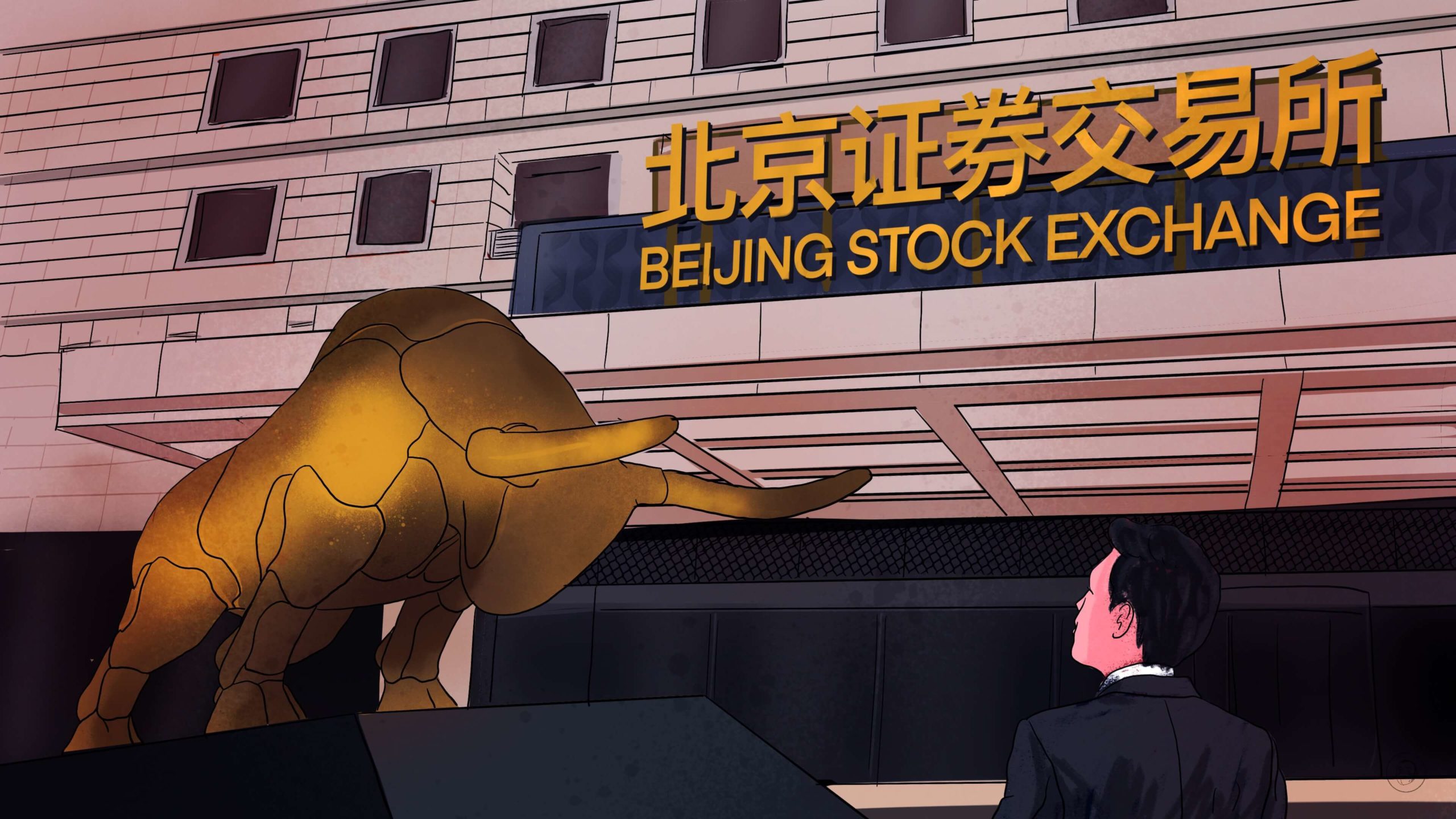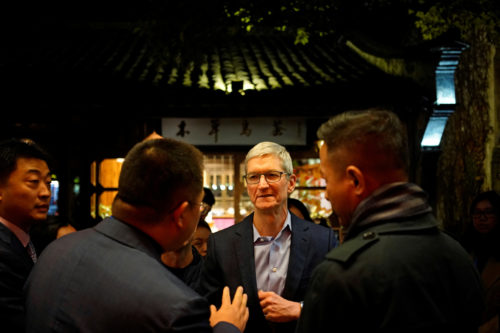The Beijing Stock Exchange is struggling, despite policymakers’ best efforts
The Beijing Stock Exchange, marketed as a place for high-tech SMEs to thrive, has seen lackluster daily trading and fundraising numbers so far in 2023, and this doesn’t bode well for China’s tech competitiveness.

The Beijing Stock Exchange (BSE) has been hyped as a home for small- and medium-sized enterprises (SMEs) that will be key to future growth, such as firms working in the green energy economy, advanced materials, and artificial intelligence. Launched in November 2021, the BSE is a place where less established firms that would find it difficult to list in Shanghai or Shenzhen can gain access to capital.
Among these firms are “little giants” (小巨人), startups working in key industries that qualify for subsidies and tax benefits. Little giants are one type of SME Beijing has identified as part of efforts to boost China’s economy. “Leading specialized” SMEs (专精特新中小企业) and “innovative” SMEs (创新型中小企业) also feature in policymakers’ plans.
Some of the hype around the BSE is merited: the Beijing bourse has seen some real growth, expanding from 81 firms at its inception to 166 companies listed today. But recent trends indicate that flagging investor enthusiasm, a difficult economic environment, and the bourse’s own structural problems may be combining to undermine its success.
Lackluster interest
Despite Beijing’s hyping of the new exchange as a hub for innovative companies, data suggests sluggish investor interest. In January, 125 stocks had an average daily trade volume of less than 0.5% (at the time of writing the BSE lists 166 firms according to its website). By comparison, so far this year, among the nearly 5,000 A shares listed on the exchanges in Shenzhen and Shanghai, only 604 of these stocks had an average daily turnover rate of less than 0.5%.
In addition to low trading volumes, firms listed in Beijing are having trouble raising capital. A number of firms planning to list on the BSE have cut their floor prices for their initial public IPOs. Among these firms are green tech firm Polygee 保丽洁, which cut its IPO price by more than 60%, and smart product solutions provider Lierda 利尔达, which lowered its initial share price by nearly 80%. On the BSE, IPOs have a minimum price for their share sales, unlike on the exchanges in Shenzhen and Shanghai.
Newly formed index funds that track firms on the BSE have also failed to meet their fundraising targets. Eight funds began courting investors at the end of November, and by December, 26 had attracted 4,738 buyers who collectively invested around 2.94 billion yuan ($436 million). While the number seems impressive at first glance, the funds had aimed for a ceiling of around 500 million yuan ($74.1 million) each during the fundraising window.
Annual data released by the BSE at the end of 2022 shows that while certain metrics increased over 2021 as expected, such as the number of companies and shares listed; others declined, such as the BSE 50, an index that tracks firms on the exchange, which closed out the year down 5.79%.
Financial analysts have noted that the BSE suffers from certain structural impediments: Smaller companies by their very nature have fewer shares and less liquidity, resulting in lower rates of turnover. And low liquidity deters quality companies from listing on the exchange, which in turn makes the exchange less attractive to investors, creating a toxic feedback loop.
New draft proposals announced on February 1 by China’s securities regulator would make it easier for firms to go public on all of China’s domestic stock exchanges, potentially making the BSE more attractive to firms and in turn to investors. The proposals still have to go through public comment and further review by policymakers before they would take effect.
China news, weekly.
Sign up for The China Project’s weekly newsletter, our free roundup of the most important China stories.
Little giants
Of the 166 companies currently listed on the Beijing exchange, 68 (about 40%) are registered with China’s Ministry of Industry and Information Technology (MIIT) as little giants. Little giants have been compared to Germany’s Mittelstand, sometimes known as “hidden champions,” recognized for being relatively obscure but crucial to supply chains in key industries. In order to be considered for the benefits associated with being a little giant, a firm must meet certain criteria, including at least three years of experience in a crucial part of the supply chain and upwards of 10% market share in their respective business.
Difficulties on the stock exchange don’t necessarily spell doom for these companies. The China Project previously found that of the 89 companies listed on the exchange in May 2022, 88 were profitable in the first half of 2021. The BSE 50 has an overall price/earnings ratio (a metric for assessing if a stock is valued accurately) that hovers around 20, indicating the shares tracked by the fund may be undervalued. Sluggish investor sentiment in recent months may have more to do with overall economic issues associated with COVID-19 infections, youth unemployment, or troubles in the real estate sector.
Beijing hopes to have identified 10,000 of these little giants by the end of 2023, but such a goal could just end up causing more problems. As officials strive to meet quotas, they may cut corners and let qualification standards slip in order to please their superiors.
Smarter industrial policy
China’s government has clearly signaled its understanding that innovation must become a bigger part of China’s economic growth going forward. A policy document promulgated by the Ministry of Finance and the MIIT in early 2021 announced a 10 billion yuan (about $1.5 billion) fund to help support qualifying SMEs.
Throwing money at problems has in the past caused issues for Beijing. In 2014, China set up government funds to foster the semiconductor industry, aiming to invest a whopping 9.5 trillion yuan (about $1.4 trillion) in developing its semiconductor industry. But opportunistic actors took advantage of the situation, cashing in on subsidies with no real intention to develop semi firms.
But Alexander Brown, an analyst at the Berlin-based Mercator Institute for China Studies, told The China Project that Beijing’s approach to the little giants program reflected an understanding of some of the pitfalls of past industrial policies.
“The whole logic behind setting up the Beijing Stock Exchange is to direct capital into strategic industries, but also to have the market play a significant role in that,” he said. “With the little giants program, the government is signaling where capital should be going, while promoting competition and allowing investors to make the final call on which firms to support.”
Brown also noted that the amount of funding on offer for the little giants is nowhere near what China has invested in semiconductor supply chains, which could partially prevent some of the corruption and embezzlement of a more blunt industrial policy. “Not all those firms end up getting significant state support, or the level of official state support is quite limited. What’s been announced, at the national level at least, is 10 billion yuan in funding until 2025, which is very small if you consider the number of little giants that they want to cultivate.”
Little giants also need to regularly prove to the government that they are worthy of their special status. “The pool of these 10,000 little giants is in flux,” said Brown. “Every three years they lose their status — they might be promoted to a higher level, or they might lose their status as a little giant.”
More challenges ahead
Even if Beijing is adopting a smarter approach to industrial policy, the little giants are facing other challenges and uncertainties. They’re operating against a backdrop of rapidly intensifying technological competition between China and the U.S. and its allies, at least in certain advanced industries. And they also still have to contend with the difficulty of wrangling logistics: Acquiring raw materials in a global environment beset by supply chain disruptions is always a challenge, but especially so for SMEs.






